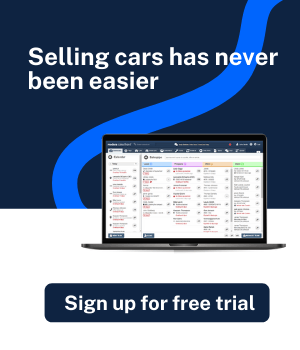In this episode, Mark and John are joined by Siim and Janek- Estonians, who live and breathe the digital automotive retail software.
They’ve spent their entire careers in the digital space of the automotive world. This time, the topic of discussion is the future of digitalization in the world of automotive. Find out how you can make the most of digitalization and get sales growing.
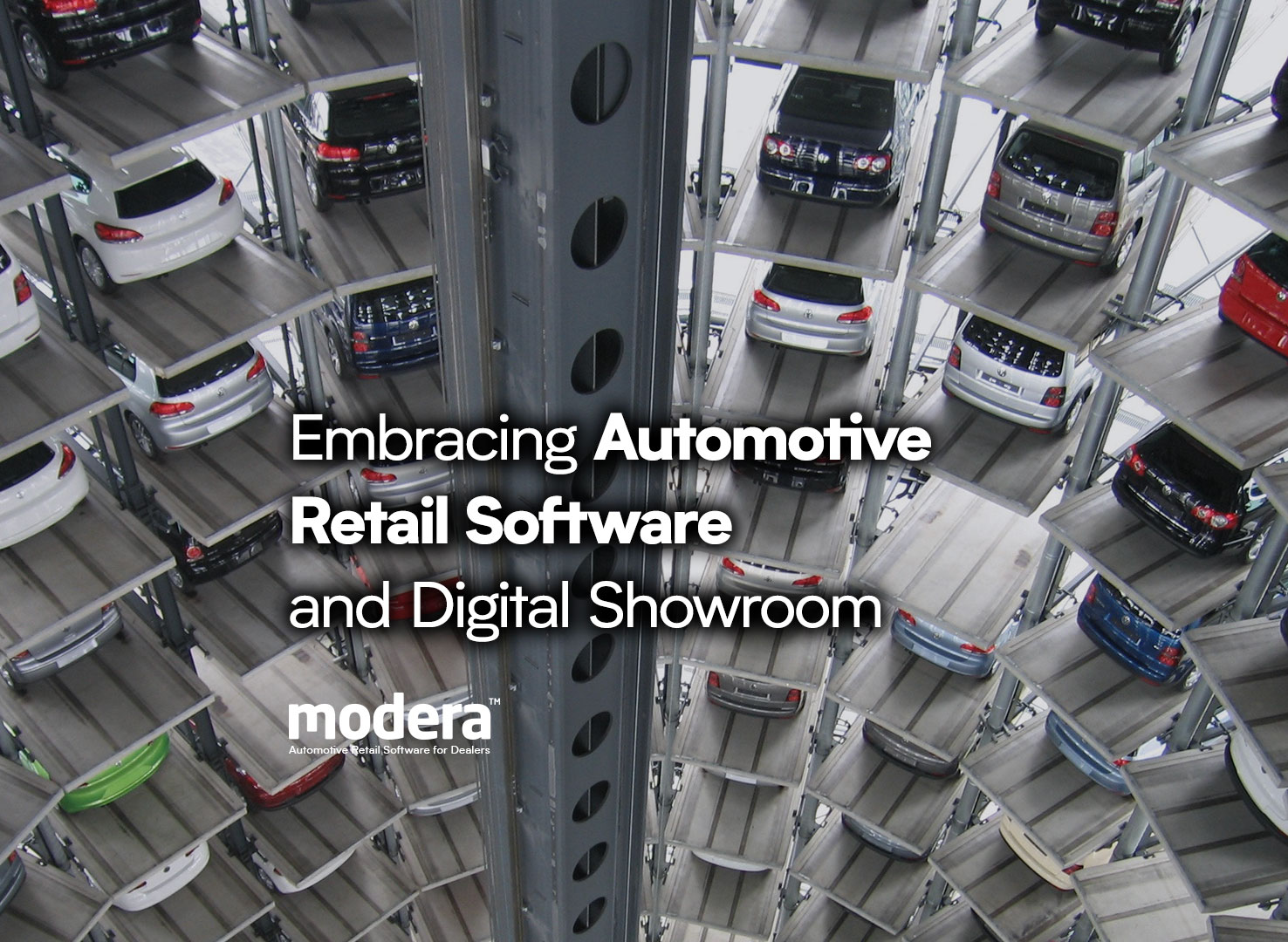
Meet Janek
Janek Prümmel has spent over 14 years in the digital space. His entire career has been in the digital world, working for various companies. Janek eats, sleeps and dreams all things digital.
Highlights from his career:
- Working with Automaster for 3 years
- Spent 9 years with CDK Global
- Working with Modera for the past 3 years.
Meet Siim
Siim Vips is an Estonian entrepreneur with nearly 20 years of experience in the digital world. He co-founded Modera Software. It’s a customer experience digital company for the automotive industry. Siim is dedicated to joining the worlds of digitalization and cars in automotive retail software.
Highlights of his career:
- Co-founder of Bisly – an intelligent building hardware and software company
- Partner at Fugira- a card and identity software. Siim has spent the past 12 years with them.
- Co-founder of Modera Software, which he has been running for nearly 19 years.
A dark horse in the race for digitalization
To give some background about Estonia, it is a small country in Northern Europe. Since breaking from the Soviet Union in 1991, Estonia has been one of the front runners in the digital space.
Not having any IT-related legacy, Estonian companies have been able to embrace innovation. They take advantage of the government support in the digital field. Estonia put its name on the digital map with the creation of Skype. You only need to leave the digital space to get married or to get a divorce in Estonia.
Embracing the digital in the automotive industry
The rule is, the simpler the product, the easier the digitalization. It has been a tall order in the world of automotive. There are both challenges and opportunities when introducing digital to the industry.
Hurdles on the digital journey
One of the key challenges Western countries face, is their long history in developing processes. Countries are still holding on to antiquated systems. This makes it difficult to embrace innovation. To move forward, it’s time to go for the shiny new toy and toss the rag doll to the side.
Since the beginning of 2000’s another challenge is solving master data management. It is important to get the right data out on the dealer website and get it done in the most efficient way.
Sales have been another obstacle when introducing digital to the automotive world. The products are difficult making digitalization a challenge. The processes involve different pre-sales activities, financing, insurance etc. It’s a lot to combine into one digitalized package.
To ease digitalization, marketing and sales have to go hand in hand. On the OEM and country office level this is still proving to be a problem. To get the digital ball rolling, sales, marketing, and production have to become one clear digitalization project.
Another issue companies face is the rotation of personnel. Projects get started with enthusiasm. But when people change, initiative runs out faster than free snacks at the office.
Making moves in a crisis
Many OEMs have been lagging behind when it comes to digitalization. With the outbreak, there’s an urgency to start making bold moves to succeed in the digital future. Otherwise, you will be biting the dust of the innovators.
If you don’t know, what’s happening on the customer level in pre-sales and sales, it’s difficult to plan your moves. You need to guarantee a steady contact with your online sales and retail systems. To survive another outbreak, you must have a solid digital processes in place.
With the current situation and customer trends, the automotive world has to make moves towards digitalization 2-3 years earlier than planned.
Digital trends in the current market
Digital tools have been used in the automotive industry for about a decade. Yet, for many years they were mainly intended for the staff. Since 2010 there’s been a shift to make use of digital tools on the customer side as well. With spending more time online, people are more open to digital innovations.
Before the crisis, only 5% of Modera Software customers were using the online sales functionalities of the automotive retail software. During the crisis, this number skyrocketed to 90%. By now, 95% of the customers are taking advantage of the online functionality. This shows a huge shift from the customer side to make the most of the digital opportunities.
To make the digital space available for everyone, the focus has to be on usability. As the younger generation has basically grown up online, it is not a problem for them. When it comes to older people, companies must make their digital space easy to navigate. By making digital tools and easy to use, they will be embraced by the elderly as well. This way companies won’t lose out on any age groups.
Making the most of automotive retail software
Not all dealers are willing to take use of the digital tools offered. The first services offered to customers online were simple services. Customers could book services and browse catalogs. It’s taken a while for dealers to hop on the bandwagon of digitalization.
For example, automotive CRM systems have been in use from around 2007 in the automotive industry. Yet, it took years for dealers to take advantage of all its functionalities. Once the OEMs pushed their dealers to embrace the new technology, processes became easier, car sales CRM gets adopted.
From company level, introducing CRM to dealerships is vital. To keep track of all the leads and not miss any opportunities, there needs to be a reliable system in place. If a salesman has established a good connection with his contacts and decides to move on, the contacts might follow. If you have a good CRM system in place, you can avoid that risk. Using your tools, you still maintain the contacts and the history related to them.
One of the biggest OEMs established a set of rules for handling leads back in 2012. Since then, there’s been a push for software companies to meet this standard. This means that software companies are constantly evolving their products. It’s up to the OEMs to take advantage of the digital tools offered.
Find out how to generate more leads to your car dealership.
Get to the customers’ level
The days of salesmen waiting for customers to come to the showroom, like kids waiting for Santa, are ending. The buyers have moved online, so this is where the salesmen and digital showroom software need to be as well.
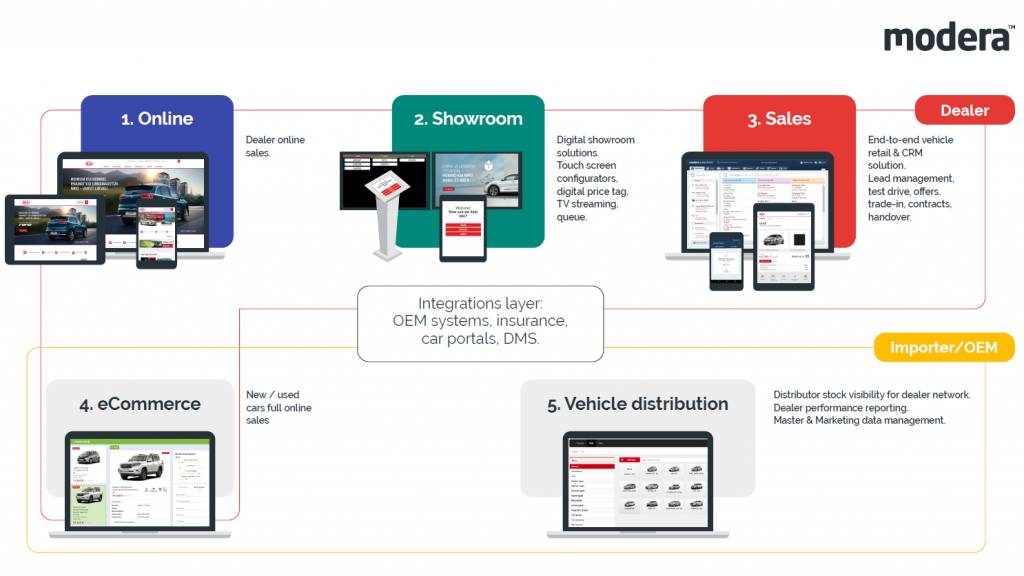
The process of Automotive Retail Software.
People are doing research online, and salesmen need to be ready for more educated buyers. The customers now know what, when and how they want. In ways, this makes the salesman’s job easier, but it also brings on new challenges. You have to manage every step of your digital sales funnel.
In some regions, buyers want to find out everything before contacting the dealership. They already have their minds made up and might question the dealer for final confirmation. This is more common in Northern Europe. Local customers are reluctant to live chat, because they want to go unnoticed.
In Western Europe, dealers should prepare to answer more questions online. There people prefer to get their answers from an actual person. In these regions, salesmen have more power for persuasion.
Let the cover reflect the book
When establishing an online presence, companies must keep their message the same. One of the main problems is the discord between the OEMs websites and the local dealerships. When a customer is looking for something, they need to get the same information on all your platforms.
Try to make the purchasing experience as similar as possible throughout different channels. If the OEMs website uses all the newest digital tools, the local dealership has to have a comparable one.
When a customer visits the showroom, they expect to have the same options as your online platforms offer. Dealerships should have digital tools like configurators and tablets. They help show the customers all the options available. This should include looking up different models, colors, etc. The shopping experience that starts on the OEM’s website has to continue on to the dealership.
Be attractive online
Customers are doing online intelligence work like the FBI. This means companies have to make their accounts attractive. To attract and maintain customers, your message needs to be inviting and visuals up to date.
Since the crisis hit, there’s been a surge in online enquires and people looking to chat via phone or online. The biggest mistake a dealership can do, is ignore those enquires. On an OEM level there’s been a push to get dealerships online. Customers should get an answer in a timely manner.
As people haven’t been able to visit the showrooms, another way to give them a similar experience is to use video presentations. Just because the showroom is closed, doesn’t mean the show is over. Here’s where the online showroom software becomes your opportunity to improve dealership profitability.
Sales in the automotive retail software
With electric cars sparking up the market, digital tools play a vital part in sales and marketing. Customers looking to buy an electric car expect to have a digital shopping experience. They should have a next generation customer experience from browsing until driving off the lot.
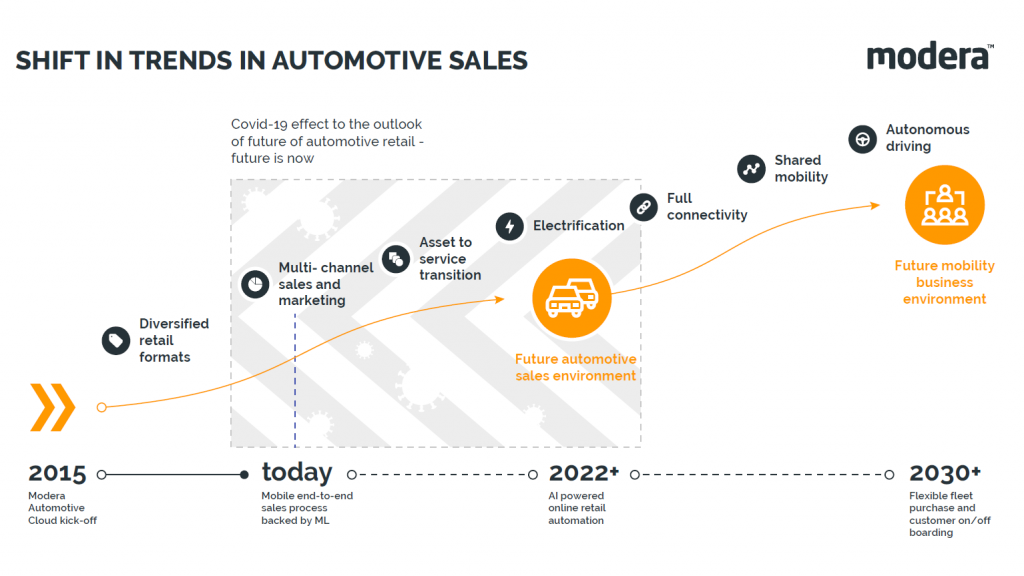
Shift in trends in automotive sales
Read more here

Raido Toonekurg: The end is near for the 100-year-old car business model
According to Raido Toonekurg, a board member of AS Modera, by the year 2030 the monetary means in the car business have moved from concrete and glass into wires and clouds. Most wholesalers and retailers have probably understood by now that their businesses are bound to change a lot within the coming years. The fact … Continue reading
To manage sales, the first thing is to have a digitalized pre-sales software in place. You must be able to monitor and collect data from your retail network in real-time and tie it all into automotive retail software. This helps you build backend and reporting systems. You can also use this software for vehicle optimization, gamification, etc.
Keep in mind, having the best digital tools does not guarantee success. You have to put them to use.
One of Modera’s biggest clients implemented Modera’s lead management system to their dealer network. But some dealers were reluctant to use the system as a hole. Modera and the importer made the decision to get rid of all manual reporting. This put the dealers in a situation where they had to use the full capacity of the system. This way the importer could get reliable and real-time information from reports. It was a win-win situation as dealers got rid of the tedious task of manual reporting.
Another great example is the automotive CRM case study for Kia Auto.
Impact of the crisis on digitalization
As COVID-19 has impacted all industries, it’s definitely changed the course of the automotive world as well. The need for digitalization has become more urgent. People expect to get all their errands and shopping done online.
The crisis has been awakening for dealerships. There is a rush to move over to e-commerce and move all the sales online. Dealerships have to be prepared for contactless sales in all departments. There will be no turning back from that, so companies who want to succeed, have to establish quality e-commerce stores sooner than later.
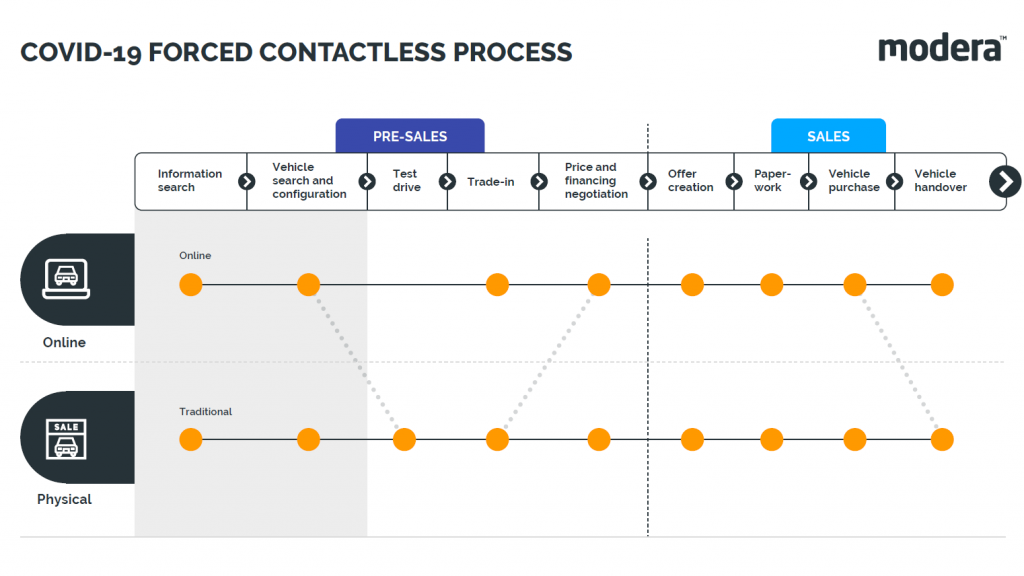
COVID-19 forced contactless process
Train online
With dealerships moving into the digital space, it’s time to take training along. Training is a vital part of any dealership’s success. Both sales training and technical training can, in most part, can be done online.
Training videos and manuals should be available online. There will always be a need for classroom training as some things can’t be taught online. However, to make training more time-flexible and convenient for all parties, most of it should be done online.
Where digital wins
In the automotive field, departments have embraced digitalization differently. When digitalization started, the first to jump on board was aftersales.
By now, sales are bypassing other departments in accepting the digital. Companies should embrace digitalization in all departments. This will help make sales and reporting convenient and clear. Guarantee that all departments and systems are connected to each other.
The more sales channels you have, the more important it is to have all systems work with each other. This way all systems display real-time overview of the processes in action. Mistakes due to lack of communication are less likely.
Stepping into virtual reality
Businesses have used virtual reality for about 20 years in the automotive industry. It has proven to be a success in technical trainings, but bringing it to the public has been difficult.
To get a good VR experience, you need a powerful computer and a headset which can put quite a dent in one’s wallet. As long as expensive hardware is needed for VR, it can’t become mainstream. VR can really take the market once you can check into VR from your home with some affordable glasses.
A few years back, Modera launched their first VR prototype. It gave the user a chance to build user their dream car.
When the customer put the glasses on, a salesperson guided them on the virtual journey. The customer sat next to the salesperson. Once the journey ended, the salesperson made their proposal. To make this experience possible for everyone, there are still technical and political challenges to solve.
Making the digital dream a reality
Digitalization and use of automotive retail software in our industry is inevitable. To make the process a success, the above-mentioned obstacles need to be dealt with.
Companies have to focus on getting the local dealers’ digital tools and data up to the OEMs’ level. OEMs should start by upgrading the process of sharing data with their dealer network. There is no room for outdated pdf and Excel formats. The digital tools are there for everyone, it’s a matter of putting them in use.
Make sure you follow this space where we blog automotive digital trends.
_______________
Cover image pexels.com
